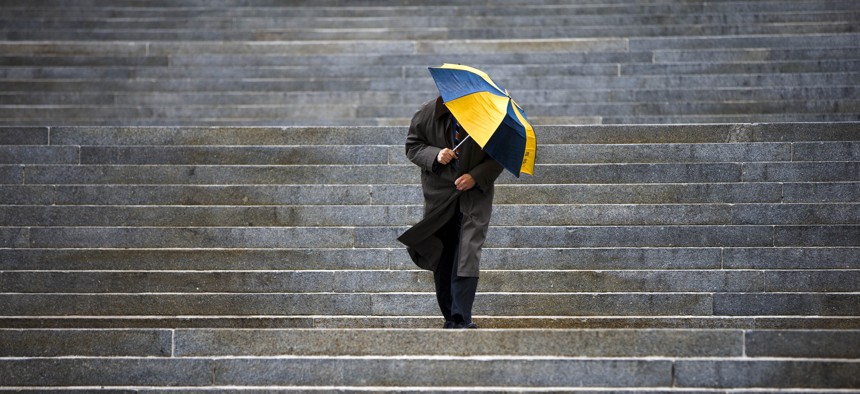How Do State Rainy Day Fund Balances Look These Days?

A man shields himself from the rain as he walks down the steps of the Pennsylvania state Capitol, in Harrisburg, in 2014. AP Photo

Connecting state and local government leaders
Not bad compared to the run-up to the Great Recession. But at least five states appear to have depleted their reserve accounts in the current fiscal year.
States governments now have a higher level of money saved overall in so-called rainy day funds than they did at the time when the Great Recession hit. But a handful of states lag in the current fiscal year when it comes to socking away these sorts of budget reserves.
That’s according to figures the National Association of State Budget Officers published in a report last week.
States can tap rainy day funds to help cover costs during economic downturns (when tax revenues typically slump and costs tend to rise), or in response to other unexpected events. The savings can provide an alternative to slashing programs when finances get tight.
All together, state rainy day fund balances totaled an estimated $49.6 billion in fiscal year 2017, down slightly from $49.7 billion in 2016, according to the NASBO report.
Those figures do not include sums for Georgia or Oklahoma, which were unable to provide NASBO with their latest rainy day fund data.
Fiscal years end in all but four states on June 30.
The NASBO report notes:
“Despite limited revenue growth, governors continue to prioritize rainy day fund savings accounts to prepare their states for a future downturn or other unforeseen circumstances. States have made significant progress in bolstering their reserve funds since the Great Recession, when rainy day fund balances fell to $21.0 billion in fiscal 2010 (or just $10.7 billion when excluding Alaska).”
As a percentage of state general fund expenditures, the median rainy day fund balance for the 2017 budget cycle was 5.5 percent.
That’s up from 4.9 percent in fiscal 2008—the recession began in December of that fiscal year. For fiscal years between 2000 and 2018 (2017 and 2018 figures are based on estimates), the same measure averaged 3.7 percent.

It’s important to acknowledge that rainy day fund balances vary widely between states.
The NASBO report points out that “this variation is related to differing fiscal conditions, rainy day fund structures, policy decisions, revenue volatility levels and other factors.”
At least five states—Illinois, New Jersey, New Mexico, North Dakota, and Pennsylvania—will have empty rainy day funds in the current fiscal year, based on estimates in the NASBO report.
The table below shows estimated rainy day fund balances in most states for 2016 through 2018.
Click on the table to expand it in a new window.

A full copy of the NASBO report, the Spring 2017 Fiscal Survey of States, can be found here.
Bill Lucia is a Senior Reporter for Government Executive's Route Fifty and is based in Washington, D.C.

NEXT STORY: As Threat of Federal Cuts Looms, Lackluster Revenues Leave States in a Tough Spot





